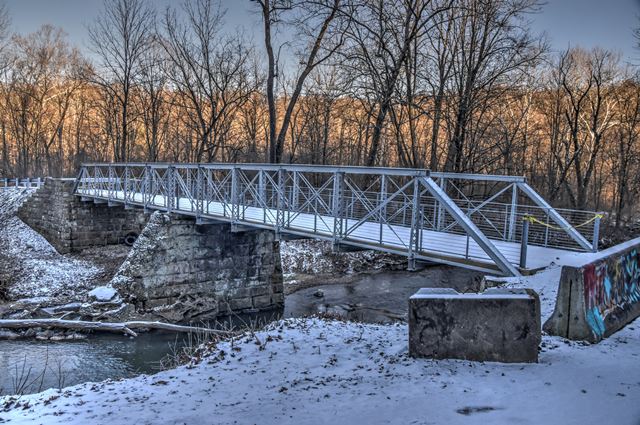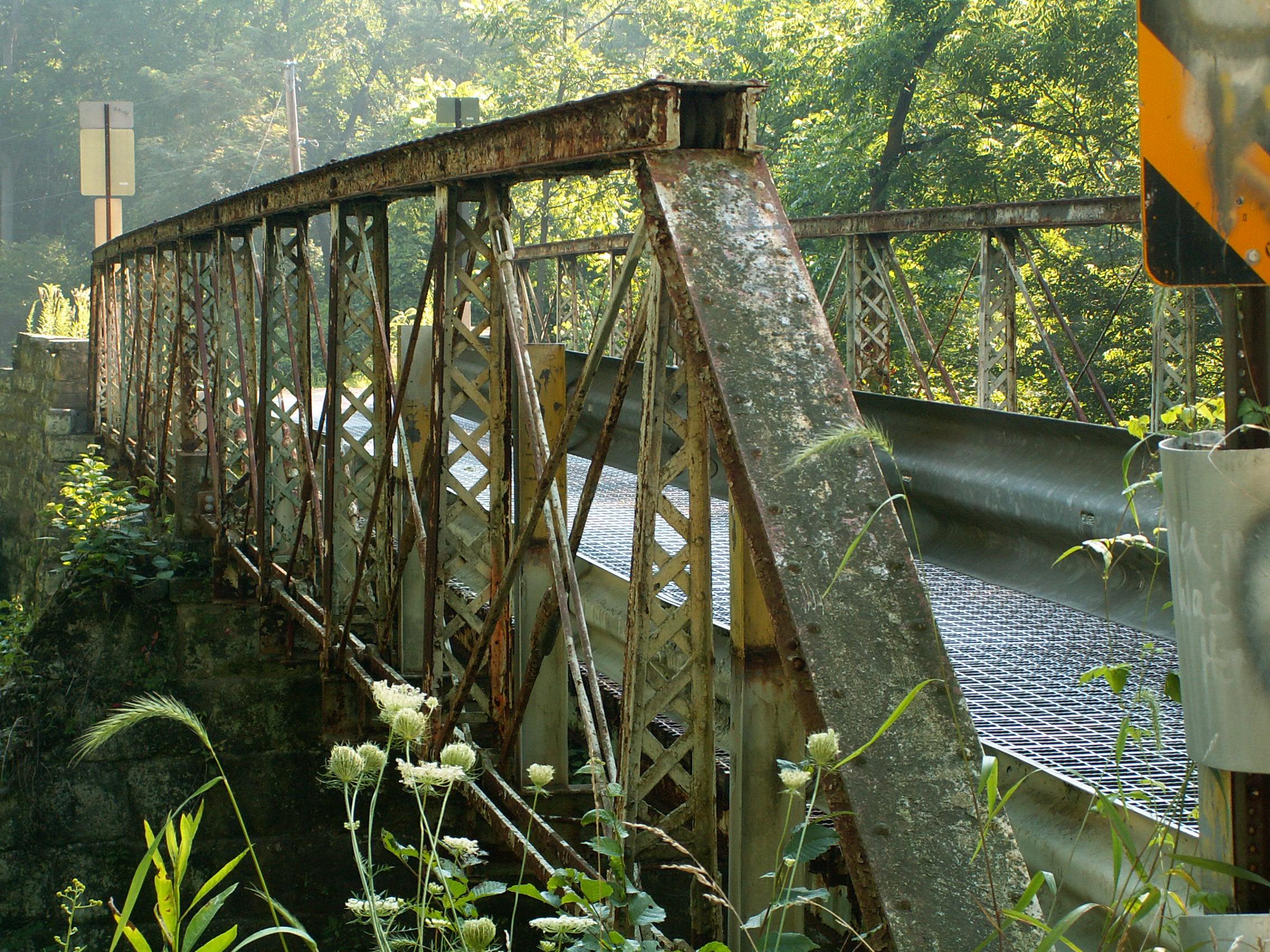We Recommend:
Bach Steel - Experts at historic truss bridge restoration.
BridgeHunter.com Phase 1 is released to the public! - Visit Now
Watts Mills Road Bridge

Primary Photographer(s): Nathan Holth and Rick McOmber
Bridge Documented: August 1, 2007, September 6, 2019, and February 1, 2023
Watts Mills Road (PA-4009) Over North Fork Little Beaver Creek
Rural: Beaver County, Pennsylvania: United States
1878 By Builder/Contractor: Penn Bridge Company of Beaver Falls, Pennsylvania
Not Available or Not Applicable
48.0 Feet (14.6 Meters)
109.0 Feet (33.2 Meters)
12.5 Feet (3.81 Meters)
2 Main Span(s)
44009006000000

View Information About HSR Ratings
Bridge Documentation
This bridge was built by the West Penn Bridge Company which later became the Penn Bridge Works (Penn Bridge Company). This is one of the earliest remaining examples of the company's work.
This bridge enjoys a large amount of historic significance for a wide variety of reasons. The most important area of significance is the span configuration of this bridge, which is a two-span continuous pony truss. It is an extremely early and rare example of a multi-span pony truss bridge using a continuous design. Continuous truss bridges were more common for large bridges, not for small pony truss bridges like this one. Indeed multi-span pony truss bridges of any design are uncommon. As such, this bridge is quite unusual and noteworthy for this use of a continuous design. In addition, the bridge is simply an early surviving truss bridge, with an 1878 construction date. This was a period where bowstring truss bridges were common; this bridge is instead an early example of a more traditional form that became common in the 1880s, the pin-connected Pratt. Another source of significance is the bridge's use of two pins at the end post / top chord connection: one for the diagonal member and one for the hip vertical member. This detail was something that the Penn Bridge Company used on many of its bridges, and is a detail that is mostly unique to the Penn Bridge Company.
For all these reasons, this bridge is one of the most important pony truss bridges in the region. Its preservation is essential, either in place, or relocated to another place. It is a key part of Pennsylvania's impressive collection of historic bridges, and is also a bridge built by a regionally prolific local bridge company.
As of 2021, this bridge is under restoration by Bach Steel and will be restored for pedestrian use, after the trusses are returned from shop restoration.
View Archived National Bridge Inventory Report - Has Additional Details and Evaluation
View the National Register of Historic Places Nomination Form For This Historic Bridge.
Information and Findings From Pennsylvania's Historic Bridge InventoryDiscussion of Bridge The 2-span, 109'-long and 15' wide, wrought iron pin connected Pratt pony truss bridge was built in 1878 by the West Penn Bridge Co. It is supported on masonry abutments and a masonry pier. The bridge is historically and technologically significant as an early example of its technology. Its unusual detailing of the center vertical illustrates period thinking about multi-span metal truss bridge design. It is also an early example of the production of the Penn Bridge Works of Beaver Falls, which was one of many bridge companies producing truss bridges for a regional market in the late 19th and early 20th centuries. Founded in 1868 in New Brighton, Beaver County, Penn Bridge moved to Beaver Falls in 1879 and changed its name from West Penn Bridge Co. Discussion of Surrounding Area The bridge carries one lane of a two-lane road over a stream in a sparsely developed, wooded setting. Bridge Considered Historic By Survey: Yes |
This bridge is tagged with the following special condition(s): Unorganized Photos
![]()
Photo Galleries and Videos: Watts Mills Road Bridge
Original / Full Size Gallery
Original / Full Size PhotosFor the best visual immersion and full detail, or for use as a desktop background, this gallery presents selected overview and detail photos for this bridge in the original digital camera resolution. This gallery offers photos in the highest available resolution and file size in a touch-friendly popup viewer.
Alternatively, Browse Without Using Viewer
![]()
Structure Overview
Mobile Optimized PhotosA collection of overview photos that show the bridge as a whole and general areas of the bridge. This gallery features data-friendly, fast-loading photos in a touch-friendly popup viewer.
Alternatively, Browse Without Using Viewer
![]()
Structure Details
Mobile Optimized PhotosA collection of detail photos that document the parts, construction, and condition of the bridge. This gallery features data-friendly, fast-loading photos in a touch-friendly popup viewer.
Alternatively, Browse Without Using Viewer
![]()
Additional Unorganized Photos
Original / Full Size PhotosA supplemental collection of photos that are from additional visit(s) to the bridge and have not been organized or captioned. This gallery offers photos in the highest available resolution and file size in a touch-friendly popup viewer.
Alternatively, Browse Without Using Viewer
![]()
Additional Unorganized Photos
Mobile Optimized PhotosA supplemental collection of photos that are from additional visit(s) to the bridge and have not been organized or captioned. This gallery features data-friendly, fast-loading photos in a touch-friendly popup viewer.
Alternatively, Browse Without Using Viewer
![]()
Maps and Links: Watts Mills Road Bridge
This bridge is closed to traffic.
Coordinates (Latitude, Longitude):
Search For Additional Bridge Listings:
Bridgehunter.com: View listed bridges within 0.5 miles (0.8 kilometers) of this bridge.
Bridgehunter.com: View listed bridges within 10 miles (16 kilometers) of this bridge.
Additional Maps:
Google Streetview (If Available)
GeoHack (Additional Links and Coordinates)
Apple Maps (Via DuckDuckGo Search)
Apple Maps (Apple devices only)
Android: Open Location In Your Map or GPS App
Flickr Gallery (Find Nearby Photos)
Wikimedia Commons (Find Nearby Photos)
Directions Via Sygic For Android
Directions Via Sygic For iOS and Android Dolphin Browser
USGS National Map (United States Only)
Historical USGS Topo Maps (United States Only)
Historic Aerials (United States Only)
CalTopo Maps (United States Only)





